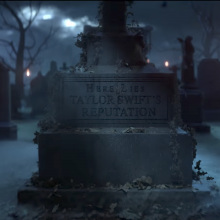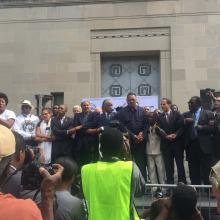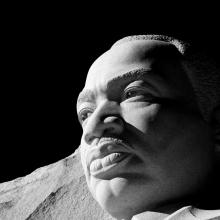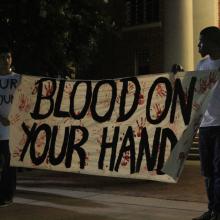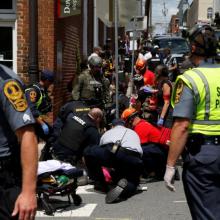Arts & Culture
Since the beginning of the year
I've had a fear of flying.
So much white anger in the air.
I can't breathe.
This present social climate presents a kairos moment for businesses pursuing social justice. In a recent New York Times interview, Apple CEO Tim Cook pointed out, “I think [business leaders] have a moral responsibility to help grow the economy, to help grow jobs, to contribute to this country and to contribute to the other countries that we do business in.” I wholeheartedly agree.
As I attempt to navigate my new normal after the traumatizing experience of standing up for love against white supremacy in Charlottesville, I am certain that empathy alone is not enough. True empathy, particularly in relation to social justice, must be followed by action. Otherwise, the cycle of marginalization, oppression, discrimination, and pain will continue.
While there are those who have embraced Swift’s new sound and video, many fans were horrified to witness “America’s sweetheart” claw herself out of her own grave. Perhaps the most startling image is the one in which Swift stands atop a mountain of past selves. It’s unnerving to watch the white T-shirt wearing “You Belong With Me” Swift lose her grip and fall with arms outstretched into the blackness.
On the 54th anniversary of the “I Have a Dream” speech, the voice of Dr. Martin Luther King Jr. echoed across the lower end of the National Mall as thousands of clergy gathered in Washington, D.C., to march for racial justice. The Ministers March for Justice brought together faith leaders of many traditions to speak out against racism and white supremacy, and sought to call the government to accountability.
Fifty-four years ago today (Aug. 28), the Rev. Dr. Martin Luther King Jr. declared in his baritone voice, which still hangs in the air all these years later, “I have a dream.” A forgotten aspect of King’s witness was his ability to move and bring about change from the “prophetic middle.” The prophetic middle is not about being politically indecisive, indifferent, or even about being a political moderate, as King was none of those. In fact he was far more radical than the domesticated version of his life that is paraded about each January.
What now? Where do churches go from here? Here are five initial thoughts I would like to share, knowing the answer isn’t simple — it will take our collective discernment from the whole diversity of our churches to continue addressing our post-Charlottesville way forward.
Many people who don’t study this sort of thing for a living may feel things are moving too quickly, and as such we can fall prey to common "straw man" arguments: “First Confederate statues, then what?” and “We shouldn’t erase history.”
Instead of preparing for the first day of school Tuesday, several hundred students at the University of Virginia spent Monday night rallying to call for more racial diversity at the school and to highlight its history of discrimination.
It’s a powerful setup, and the girls’ (and their team’s) journeys are inspiring. But it’s hard to shake the feeling that Lipitz is more concerned with crafting a tidy, three-act narrative than with taking an honest look at who these girls are, and the issues they face.
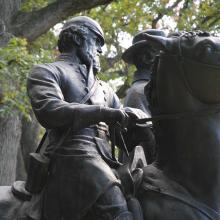
Image via Baltimore Heritage/Flickr
This morning's statue removals follow a weekend of violence in Charlottesville, Va., centered on the planned removal of a statue of Confederate general Robert E. Lee. On Monday, the Baltimore city council voted to remove and destroy the statues. That process took nearly immediate effect, in the middle of the night Tuesday and early Wednesday.
At least one vehicle hit a crowd of people gathered in Charlottesville, Va., on Saturday, hours after police broke up a clash between white nationalists and counter-protesters, according to witnesses.
Can you imagine one of the white supremacists in Charlottesville, Va., making this same argument for the swastika, somehow trying to suggest that it isn't a display of hate but of the heritage of the ancient Hindu principle of "making of goodness"?
More than 50 years later, California still lists lethal gas as a legal execution means. So do five other states: Arizona, Mississippi, Missouri, Oklahoma, and Wyoming, although Mississippi and Oklahoma, which use nitrogen hypoxia, don’t use that term. (More on that below). I learned this as I searched on my phone standing in front of John Singer Sargent’s monumental 1919 painting “Gassed,” which is on display in the New-York Historical Society’s exhibition “World War I Beyond the Trenches” (through Sept. 3).
The newly released movie Detroit inflames past wounds of race, poor economic conditions, and police brutality in a city still gripped with these issues. I won’t give spoilers to the movie but I will share how Congresswoman Maxine Waters’ recent trending statement ‘reclaiming my time’ provides wisdom for a divided community to heal and waste no time re-living the past.
We’re made in the image
The Message expresses,
The Good News attests
That we’re formed out of sod,
That we’re made every one
1. When To Trust A Story That Uses Unnamed Sources
When are unnamed sources valuable, and when do they undermine credibility? FiveThirtyEight presents a five-step graphic to how to weigh your daily news.
2. Why Is the U.S. Handcuffing Incarcerated Women In Childbirth?
Just five percent of women in the world live in the U.S., but the U.S. accounts for nearly 30 percent of the world's incarcerated women.

Image via Eva Blue/ Flickr
Gay is a true prophetic voice. She laments her life, her trauma, and her weight. She doesn’t promise victory but speaks to the pain that so many people feel: victims and survivors of sexual violence, bisexual people, fat people, and lonely people.
But really, the best performance in the film belongs to Nanjiani —no surprise, since it’s partly his own story. The affection he feels for his parents makes him afraid to upset them, but to really come into his own as a person, and as a comedian, he has to be honest with them about what he wants for his life.
In a letter published in Teen Vogue Wednesday, 114 survivors of sexual assault ask Secretary of Education Betsy DeVos not to dismantle Title IX guidance they say “enabled many of us to complete our education.” The letter comes the day after it was announced that DeVos would this week meet with survivors’ rights groups — alongside men’s rights groups — to advise the department on the government’s role in ensuring Title IX enforcement.



